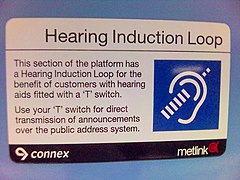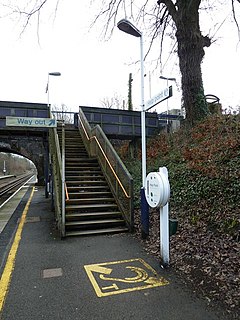Proposal:Hearing loop
| Hearing loop | |
|---|---|
| Proposal status: | Draft (under way) |
| Proposed by: | AlephNull |
| Tagging: | hearing_loop=yes
|
| Applies to: | |
| Definition: | Indicate the presence of a hearing induction loop, a particular type of assistive listening technology. |
| Statistics: |
|
| Draft started: | 2021-12-20 |
Proposal
Proposed is the tag hearing_loop=yes, indicating that a feature has a ![]() hearing induction loop.
hearing induction loop.
Rationale
Hearing loops are an assistive listening technology. They can be deployed as whole-room systems or as smaller systems integrated into counters. Whole-room systems can be found in auditoriums, churches, cinemas, and other large public places. Counter-integrated systems can be found at ticket booths, information desks, and in government offices, easing communication in potentially difficult listening conditions. Some countries have introduced legislation requiring the installation of hearing loops for newly built or extensively renovated buildings of certain types and minimum size.
Mapping hearing loops enables users of telecoil-equipped hearing aids and cochlear implants to choose between POIs based on the presence of hearing loops (e.g. when choosing a cinema). An open database of hearing loops could also be useful for visualizing progress in making public spaces and transportation accessible. Local advocacy groups often maintain small databases of hearing loops, but there seem to be no global and easily editable databases for hearing loops. These smaller databases are also usually not well integrated with other map data. Finally, as of August 2022, Google Maps has started adding information about hearing loops, so users may come to expect this information to be available in online maps.
There already exists sporadic tagging of hearing loops in the OSM database.
Some are mapped with deaf:description:ISO 639-1=* only.
hearing_impaired:induction_loop=*
|
|
induction_loop=*
|
|
hearing_loop=*
|
|
audio_loop=*
|
Key name
The key induction_loop=* could be potentially ambiguous, since there are other types of induction loops, some of which may be relevant to OpenStreetMap. For example, induction loops are sometimes used to detect traffic.
The key audio_loop=* has seen usage in France, but
it has the downside of not being a typical English term for hearing loops.
It also does not return useful information when searched for on the internet,
which may leave people confused about the meaning of the tag.
A longer or namespaced key would be unwieldy.
hearing_loop=* is the shortest mostly unambiguous key name.
Tag values
The main value is yes, indicating that a correctly installed and functional hearing loop is present.
The value limited can be used for features with multiple (functionally) separate areas where only some areas have hearing loops.
For example, a cinema where not all screening rooms have hearing loops would be tagged with hearing_loop=limited.
However, a church where only the balcony seats lack coverage would still be tagged with hearing_loop=yes.
The value no can be used for features where the presence of a hearing loop may be expected or required by legislation, but is not present.
This will vary between regions, so tagging of features with hearing_loop=no should be done with agreement with local communities.
For example, local communities might find it acceptable to tag places of worship explicitly with hearing_loop=no, but this won't make much sense
in regions where no place of worship has a hearing loop.
Further custom values are possible. For example, the value bad could be used to tag incorrectly installed hearing loops.
However, only yes, limited, and no are formally proposed here.
Detailed descriptions of the coverage of a hearing loop can be given with the help of the existing tag deaf:description:ISO 639-1=*.
Tagging
The tag should be added to the feature that is made accessible by the presence of the hearing loop. Usually there will be signage advertising the hearing loop. Signage typically features a white ear symbol and/or a T (for telecoil) on a blue background.
Features where hearing loops might be found
- transit platforms, airport waiting areas, and lifts
- ticket booths, information desks, and government offices
- auditoriums, churches, cinemas, lecture halls, arenas, and similar venues
- other public buildings and areas
A DisabilityDescription can be used for more detailed tagging of a hearing loop, since the coverage and quality of systems can vary in ways that would be hard to capture in a reasonably compact tagging scheme (or would require extensive indoor mapping).
Relevant international standards
Hearing induction loops are regulated internationally by IEC 60118-4 ("Electroacoustics - Hearing aids - Part 4: Induction-loop systems for hearing aid purposes - System performance requirements") and IEC 62489-1 ("Electroacoustics - Audio-frequency induction loop systems for assisted hearing - Part 1: Methods of measuring and specifying the performance of system components"). In Europe, these are adopted as, e.g. DIN EN IEC 60118-4:2018-08, and the UK additionally has the code of practice BS 7594 ("Code of practice for audio-frequency induction-loop systems"). In the United States, assistive listening requirements are covered under the Americans with Disabilities Act, with hearing loops commonly specified using IEC 60118-4. These standards ensure that properly installed loops deliver clear, intelligible sound and are signposted with the ISO 7001 symbol (ear with a "T").
Examples
Example Tagging
| image | tagging |
|---|---|

|
|

|
|

|
|

|
|
| https://uni-tuebingen.de/fileadmin/_processed_/8/2/csm_Induktive_H%C3%B6ranlage__2__f9839d3146.jpg |
|

|
|
Examples of existing resources or maps listing hearing loops
- Switzerland: https://hoeranlagen.ch
- Germany: https://www.schwerhoerigen-netz.de/induktive-hoeranlagen
- Christchurch (NZ): https://ccc.govt.nz/culture-and-community/strengthening-communities/accessibility-map
Rendering
As with wheelchair=*, most map styles won't render hearing_loop=*.
Special purpose maps and infoboxes may show a pictogram similar to the ISO 7001 symbol PI PF 072.
Features/Pages affected
- Disabilitydescription
- How to map for the needs of people with disabilities
- Pages for features that commonly have hearing loops may also mention
hearing_loop=*, ideally grouped together with other accessibility tags such aswheelchair=*. Examples includeamenity=place_of_worship,indoor=room,tourism=information, andhighway=elevator.
External discussions
Comments
Please comment on the discussion page.